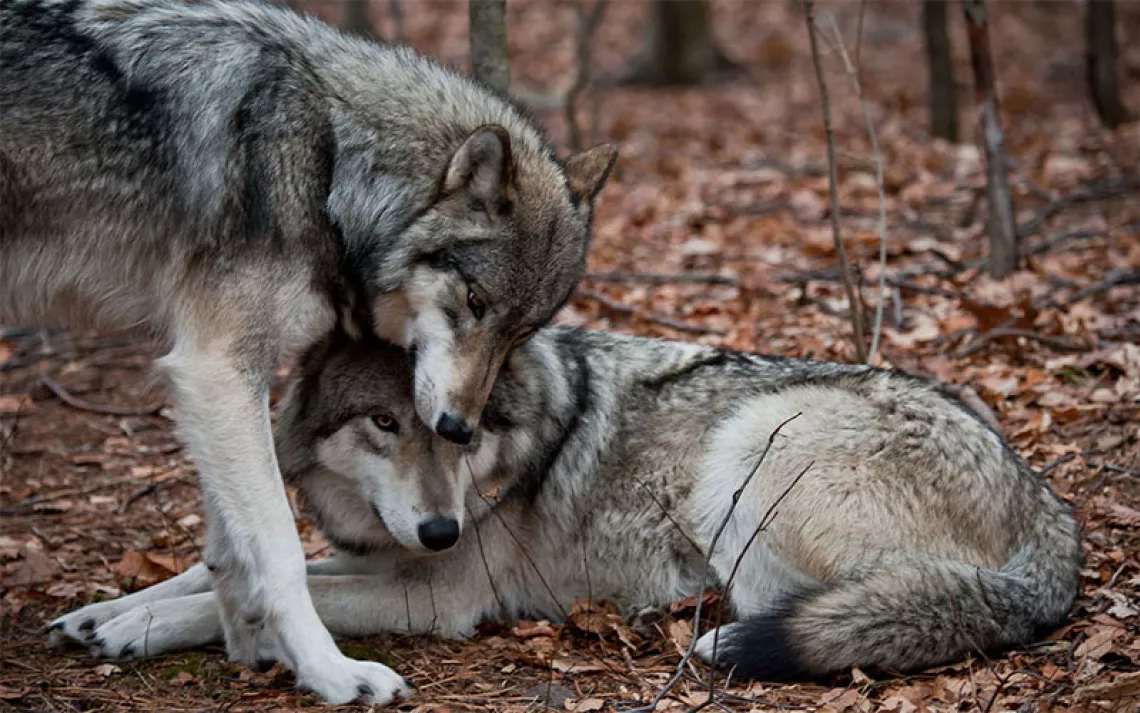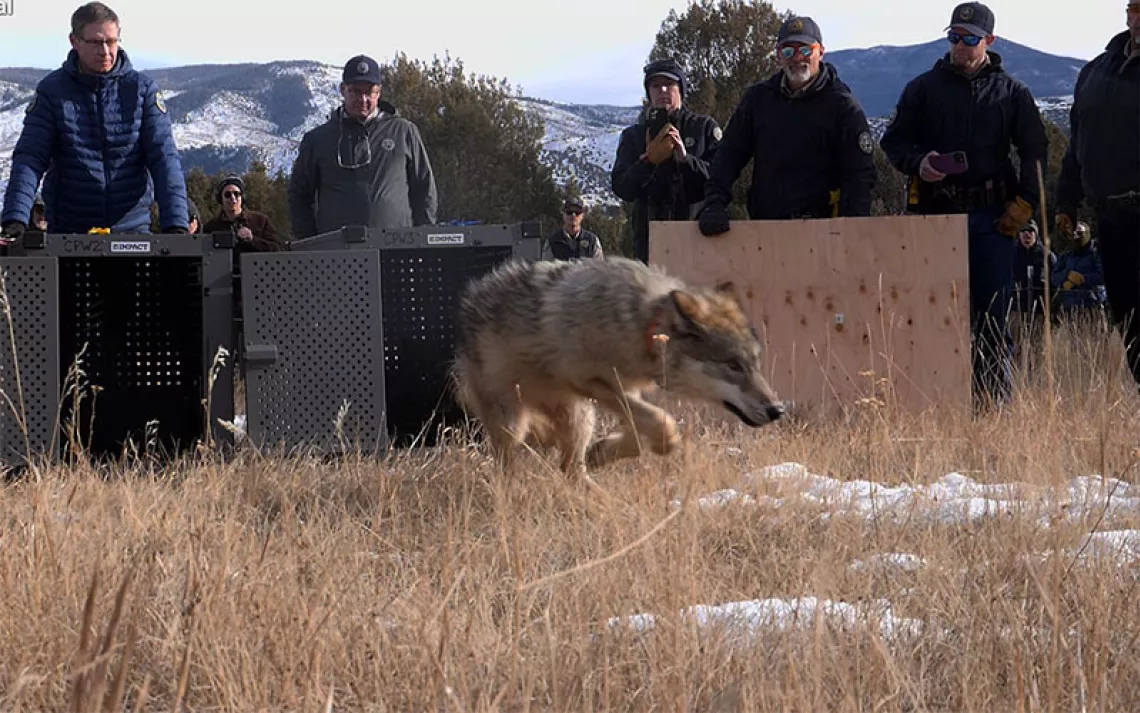Wyoming Is Waging a War on Wolves
The Cowboy State’s scorched earth campaign threatens wolf recovery

Photo by mlharing/iStock
Ever wanted to kill a wolf? If so, now’s your time. In Wyoming, wolf hunting is now legit—365 days a year across 85 percent of the state, where wolves are classified as shoot-on-sight vermin. Guns, snares, explosives, trucks, and snowmobiles—almost any form of violence is allowed to kill these animals. Today anyone in most of Wyoming can kill wolves without a hunting license, putting at great risk a wildlife species whose populations in the Lower 48 remain a dim shadow of what they once were and whose recovery in the Rockies is tenuous at best.
And what about the other 15 percent of the state, concentrated around the Jackson Hole area and the Tetons? That’s a “trophy area” where wolves may be seasonally hunted from October 1 to December 31. Unlike much of the rest of Wyoming—where ranches and extractive industries have seriously degraded valuable wolf habitat—the northwest corner still offers wolves, grizzlies, and the other large predators remaining in the West a corner in which to struggle to survive.
And now even that refuge is under fire. During the 2017 hunting season (the first legal hunt in Wyoming since 2013), licensed hunters killed 44 wolves in the trophy area—12 alone within the first 40 hours of the open season. Another 32 were killed across the rest of the state last year. And at least 48 are estimated to die annually from human impacts outside of hunting. To put this in perspective, before wolves were removed from Endangered Species Act protection, there were approximately 380 wolves inhabiting Wyoming’s 97,814 square miles. In a single year, Wyoming may have lost a quarter of all its wolves.
How did this happen? Let’s take a look back. In 1995, the U.S. Fish and Wildlife Service reintroduced wolves to Yellowstone National Park. The wolves prospered, multiplied, and eventually offered affirmative proof of this animal’s importance to ecosystem health. The successful reintroduction also demonstrated that, almost incredibly, there was still sufficient unimpeded wilderness in the continental United States to allow this far-ranging alpha predator to thrive. The growing number of packs steadily expanded their range as succeeding generations of wolves began to disperse, following the elk herds on their seasonal migration southward out of Yellowstone and into the Tetons. And that’s when the trouble began.
In 2003, just eight years after the Yellowstone reintroductions, the USFWS reclassified the endangered gray wolf under the ESA as threatened, thereby downgrading its protective status. The USFWS, fatigued from years of having to manage the intense public opinions that surround this species, was eager to stop having to oversee wolf management and began planning the wholesale removal of the “recovered” Northern Rockies populations from the ESA. The agency planned to devolve wolf management to the states of Wyoming, Idaho, and Montana, which under law would have to devise management plans that would ensure the maintenance of minimum sustainable populations.
For more than a decade, wildlife advocates fought the attempted delisting in court. The wolves in the Northern Rockies bounced back and forth between being legally protected and at the mercy of state agencies. After a brief period under state management, Wyoming wolves were placed back under the protection of the ESA. A 2009 federal district court decision held that the entire state constituted a “significant portion” of the wolves’ range—a proven historical fact, all the more pertinent given the depleted numbers of wolves throughout North America today.
But in March 2017, the D.C. Circuit Court reaffirmed Wyoming’s wolf management plan, ruling that the “2009 decision has been overtaken by events.” According to the court, the USFWS “has adopted a new definition of ‘significant portion of its range,’” allowing wolves outside the trophy zone to be destroyed with no repercussions to the species recovery across the greater Yellowstone ecosystem. Therefore, the court held, “The [USFWS] has offered ample rationale for determining that the predator area was never ‘envisioned to meaningfully contribute to wolf recovery in the region’ and is thus not a ‘significant portion of its range.’” Wyoming’s wolves were overnight reduced from a federally protected species to vermin across 85 percent of the state.
Idaho and Montana have adopted a more traditional approach to wolf hunting based upon districts, season licenses, and quotas. While those licensed hunting programs have still proved lethal to wolves—at least 271 wolves were killed in Idaho 2016, and 247 in Montana—they are not as sweeping as the no-holds-barred approach across most of Wyoming.
What’s behind Wyoming officials’ antipathy toward wolves? The primary justification for the state’s wolf hunt is, supposedly, economic. Wolves are blamed for livestock depredations in a region that is still emotionally and economically invested in the teetering myth of the independent cowboy, despite the fact that many ranchers graze their herds on public lands and insist that representatives of the USDA’s Wildlife Services agency employ any number of methods—including, per the USDA website, “trapping, snaring, shooting, and the use of chemical products and immobilization and euthanasia drugs”—to remove or kill offending predators.
According to the USFWS, wolves killed a record number of livestock in 2016, including 154 cattle, 88 sheep, and one horse; that’s up from a total of 134 depredations in 2015. In response, government “wildlife managers” killed 113 wolves, up from 54 the year before. To put this into context, the 2016 casualties from disease and weather alone among Wyoming’s sheep herds was 37,550 animals.
Wyoming residents are permitted to shoot on site any wolf they find that is attacking or “molesting” livestock or a domesticated dog. Ranchers are also able to seek compensation for livestock lost to wolves. A brochure published by Wyoming Game and Fish states “Landowners may be compensated for verified damage to livestock caused by wolves. Landowners must submit a signed and notarized damage claim affidavit to the WGFD.” But even though ranchers may get financial relief for any wolf attacks on their livestock, some ranchers insist that the wolves still have to die.
Why do wolves kill livestock? Because they’re easy prey, bred by humans over millennia to be pliant. As Andrea Santarsiere, an attorney with the Center for Biological Diversity, told US News and World Report last summer, “When you have native predators on the landscape and non-native livestock on the landscape, it’s not surprising that the predators are going to view them as prey.”
This all makes scientific sense—but science isn’t the issue in Wyoming. Rather, it’s the occasional threat to livestock growers’ incomes that fuels the attacks against wolves and other predators. But predators are hardly the main problem; according to the USDA, in 2015 non-predator causes of death (mainly respiratory diseases) accounted for almost 98 percent of adult cattle mortality, and almost 89 percent for calves. Of the numerical sliver of cattle and calves that were killed by predators, wolves took only 4.9 percent, while coyote predation came in at 40.5 percent. Even domestic dogs claimed 11.3 percent, more than twice that of wolves.
The second reason for an intensive wolf hunt is the perceived reduction of trophy game such as elk, deer, bison, and moose. For the last few generations, big game has been abundant throughout much of the West, in part because of predator persecution. According to Yellowstone National Park’s website, “Early-20th-century protectionist policies, including the elimination of wolves and cougars, boosted elk numbers and stoked concern that the herd was too large. In response, park managers and hunters shot, trapped, and relocated tens of thousands of elk between 1920 and 1968.”
The annual elk slaughter was conducted primarily to prevent damage to important biotic features such as the cottonwoods and willows that stabilized stream banks; without any fear of predation, elk herds would simply stay put streamside and gnaw new shoots to the roots, eventually resulting in erosion, sedimentation, and the loss of freshwater trout habitat. Large carnivores were reintroduced to the landscape in part for this reason: They keep prey species below their maximum carrying capacity and in the process hold diseases in check and balance ecosystems. With the reintroduction of wolves, and a concomitant increase in grizzly numbers (the bears will sometimes appropriate or scavenge the remains of wolf kills), Yellowstone’s bloated elk population rapidly decreased by around 65 percent.
But this turned some hunters against the resurgent wolves. The trophy males that are the chief interest of hunters are (if not infirmed by age) usually the healthiest and strongest members of the herd. Anyone who has encountered a cantankerous 1,500-pound bull moose standing seven feet at the shoulder will understand the reluctance of any predator to challenge it head on. Predators naturally target the easiest, least demanding prey: the young and old, the sick and lame. Therefore the impact of wolves to healthy adult male elk, mule deer, bison, or moose is ecologically minimal.
As it currently stands, Wyoming’s wolf management plan requires the maintenance of a 100 x 10 ratio: that is, 100 wolves with at least 10 confirmed breeding pairs in the entire state, not including Yellowstone National Park or the Wind River Shoshone/Northern Arapahoe Reservation. The plan also calls for state biologists to define a “buffer” against this minimum required population, which presumably would mean more wolves than the required minimum. But the buffer, already vague, is not a legal requirement of the state’s management plan.
And in any case, the Wyoming plan appears to violate federal guidelines, according to attorneys with the nonprofit advocacy group Earthjustice. Under federal regulations, Wyoming must retain a total of 150 wolves, including 15 breeding pairs, throughout the entire state, including the national parks and the trophy game area. Although the state can take the population down to the bare minimum and still remain within the law, the targets seem arbitrary, says Timothy Preso, managing attorney of Earthjustice’s office in Bozeman, Montana.
“There is huge pressure on the ‘trophy zone’ to maintain a viable population without a legal safety net,” Preso said. Reestablishing wolves was a huge and successful effort by the American taxpayer, he said, one that has been sacrificed to extremists who may use any means not already illegal, like certain poisons, to wipe out wolves. “They can dynamite pups in their dens, run them over with snowmobiles, shoot them, trap them.” Preso continued, “There’s not a rational discussion underlying the management of wolves in Wyoming. They’re such a symbol of different things. To some people they epitomize wilderness and freedom; to others they’re pure evil, even somehow scapegoats for dislike of the federal government.”
Preso said the statewide “dual classification” zoning system that is unique to Wyoming, along with the state’s lack of a meaningful buffer to support the minimum required numbers of this isolated population, is at the heart of conservationists’ issues with the Wyoming plan. “We will continue to fight to protect wolves against extreme and hostile state management policies,” he said.
Ken Mills, wolf management specialist with Wyoming Game and Fish, neatly summed things up regarding his state’s unprecedented ability to devastate an ecologically vital, formerly federally protected species. “There’s no other jurisdiction that has to manage wolves the way we do,” Mills told the Jackson Hole News & Guide last spring. “We have a much smaller population [compared with other Northern Rockies states] and a smaller area of suitable habitat. But on the plus side Idaho and Montana can’t manage their populations; they can’t overharvest their population. We can. Essentially we’re managing a population in a brand-new way.”
 The Magazine of The Sierra Club
The Magazine of The Sierra Club



